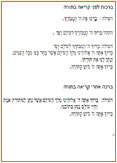

Learn about the order of the Torah service and some basic terms
1


Fill in the blanks and find the correct Torah portion
2


Learn to read the Haftarah and its blessings
3


Learn the Maftir reading


Practice the entire Maftir reading


Learn the blessings for being called up to the Torah



Printouts to download



What are the blessings before and after being called up to the Torah?



The blessing before the Maftir



The blessing after the Maftir
4


Practice makes perfect
5




































